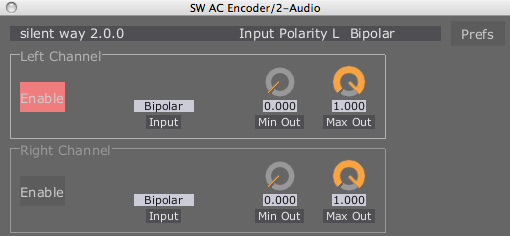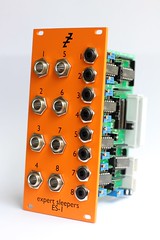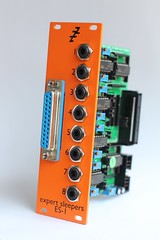Silent Way
AC Encoder
Introduction
Silent Way AC Encoder removes the need for a DC coupled audio interface and lets you use Silent Way with almost any audio interface. All you need to do is to make some special cables or a breakout box - or buy a suitable converter module (see below).
The cables are a very simple job, well within the scope of anyone with basic soldering skills.
Note that without additional circuitry or processing the CVs recovered from the AC Encoder system will be positive voltages only. In practice this is often not a problem, and if it is there are a number of modules on the market that will provide a DC offset (e.g. Doepfer A-183-2 or A-138).
For further usage details, please see the Silent Way User Manual (available on the downloads page).
Expert Sleepers disclaim any responsibility for damage to audio interfaces, synthesizers or other hardware caused directly or indirectly by evaluating and using this software.
Cables/Interfacing Circuit
There are a number of simple circuits that will work with Silent Way AC Encoder, to interface a non-DC-coupled audio interface with an analogue synth. All involve some kind of rectifier. More exotic circuits such as voltage multipliers can also be used to great effect.
A number of alternatives are explored at this forum thread, where you'll also find results from various users who have built the circuits.
The simplest circuit you can use with Silent Way AC Encoder is this:
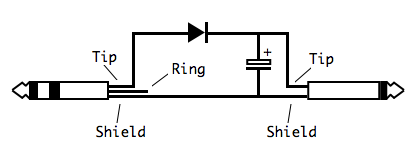
So that's just one diode and a capacitor. You can even solder this directly into a regular cable - grab an off-the-peg stereo jack lead, a diode and a capacitor (total cost under $1), open up the plug at one end and solder the components together. (The circuit shows TRS (stereo) (audio interface end) and TS (mono) (synth end) jack plugs, but if you buy an off-the-shelf TRS-TRS cable you can just short out the ring and shield at the TS (synth) end.)
See below for details on what diodes and capacitors to use.
This photo shows a similar circuit soldered directly onto a jack plug:
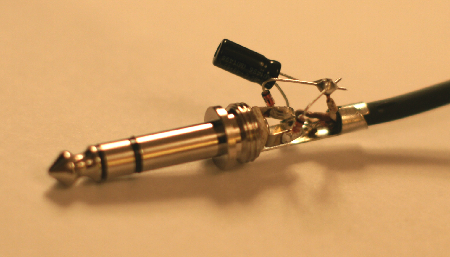
and that's really all you need, plus Silent Way AC Encoder, to use Silent Way with almost any audio interface.
These photos show a slightly more complex circuit (a bridge recitifier in this case) soldered between pairs of jack sockets, to make a simple passive breakout box, again at very low cost (the most costly part of this is the panel). You may notice that channel 2 here has another refinement - an LED to provide a visual indication of the CV level.
Tested Component Values/Interfaces/Synths/Modules
This solution was first mooted on this forum thread, and there is some good information there on what combinations have been tried already.
The original Expert Sleepers circuit used two 1N4148 diodes and a 1uF electrolytic capacitor. 1N914 diodes have also been used successfully by others. While the diodes remain a good choice, it seems that a smaller capacitor works better for most people - down to about 0.2uF.
The following audio interfaces have been reported working with Silent Way AC Encoder, though as mentioned above, almost any interface should work. Please email us or post on the forum if you have any additions for the list.
| Metric Halo Mobile I/O 2882 |
| Behringer ADA8000 |
| TASCAM US-1641 |
| TASCAM FW-1884 |
| Edirol FA-66 |
| Digidesign Digi 002 |
| Native Instruments Audio Kontrol 1 |
| ESI ESP1010 |
| PreSonus DigiMax FS |
| M-Audio Fast Track USB |
| M-Audio Delta 1010 |
Active circuit
If you prefer an off-the-shelf hardware solution, please consider the Expert Sleepers ES-1 module.

